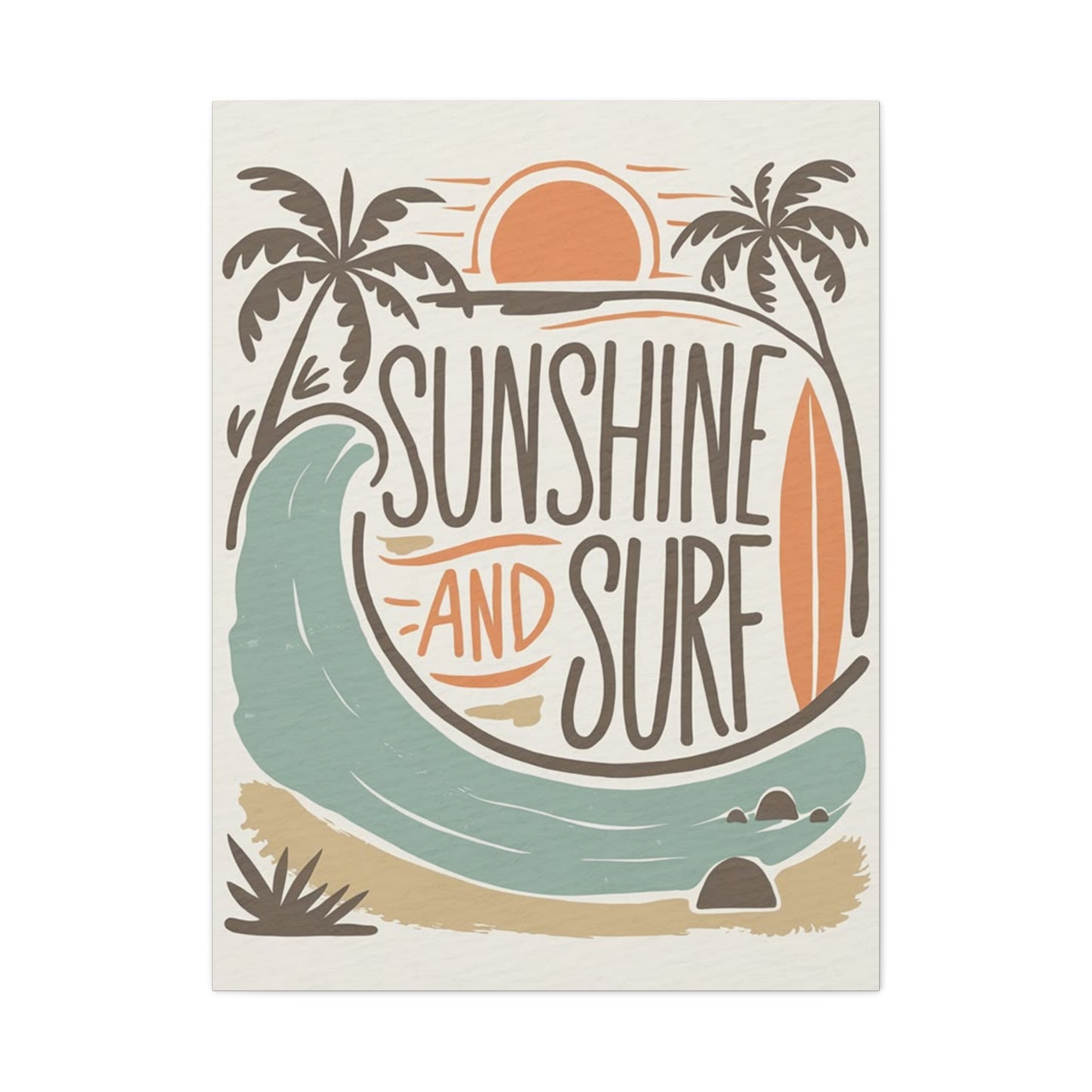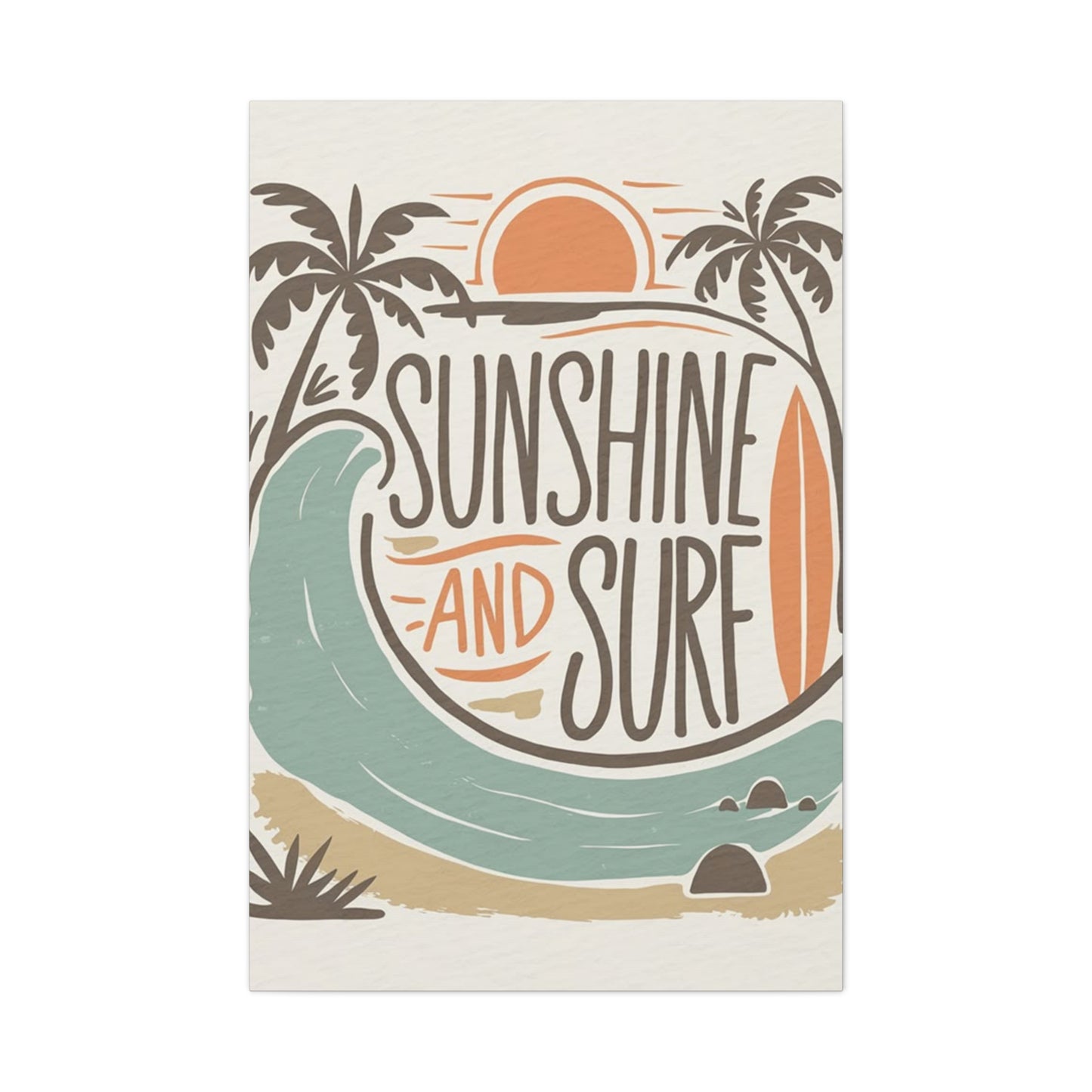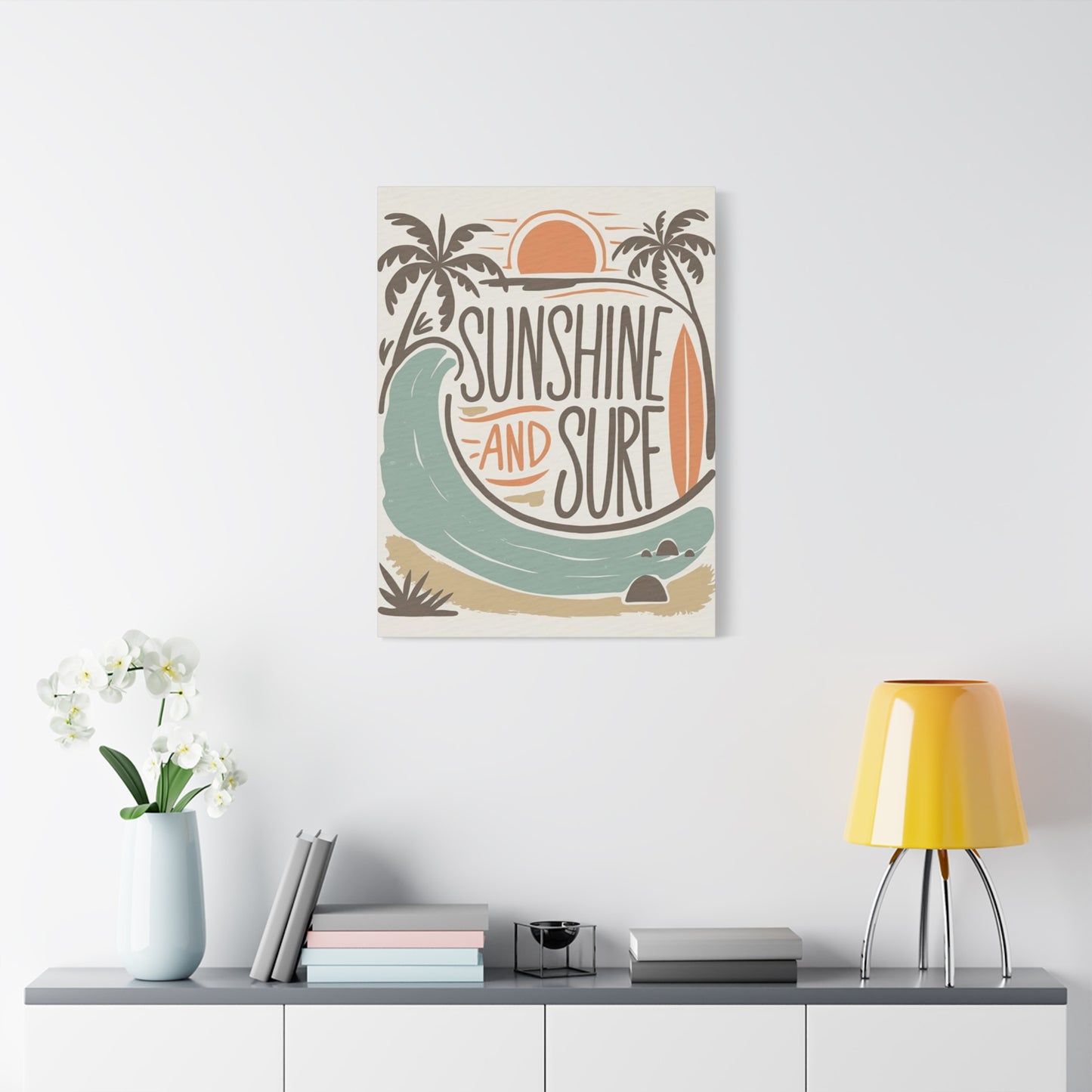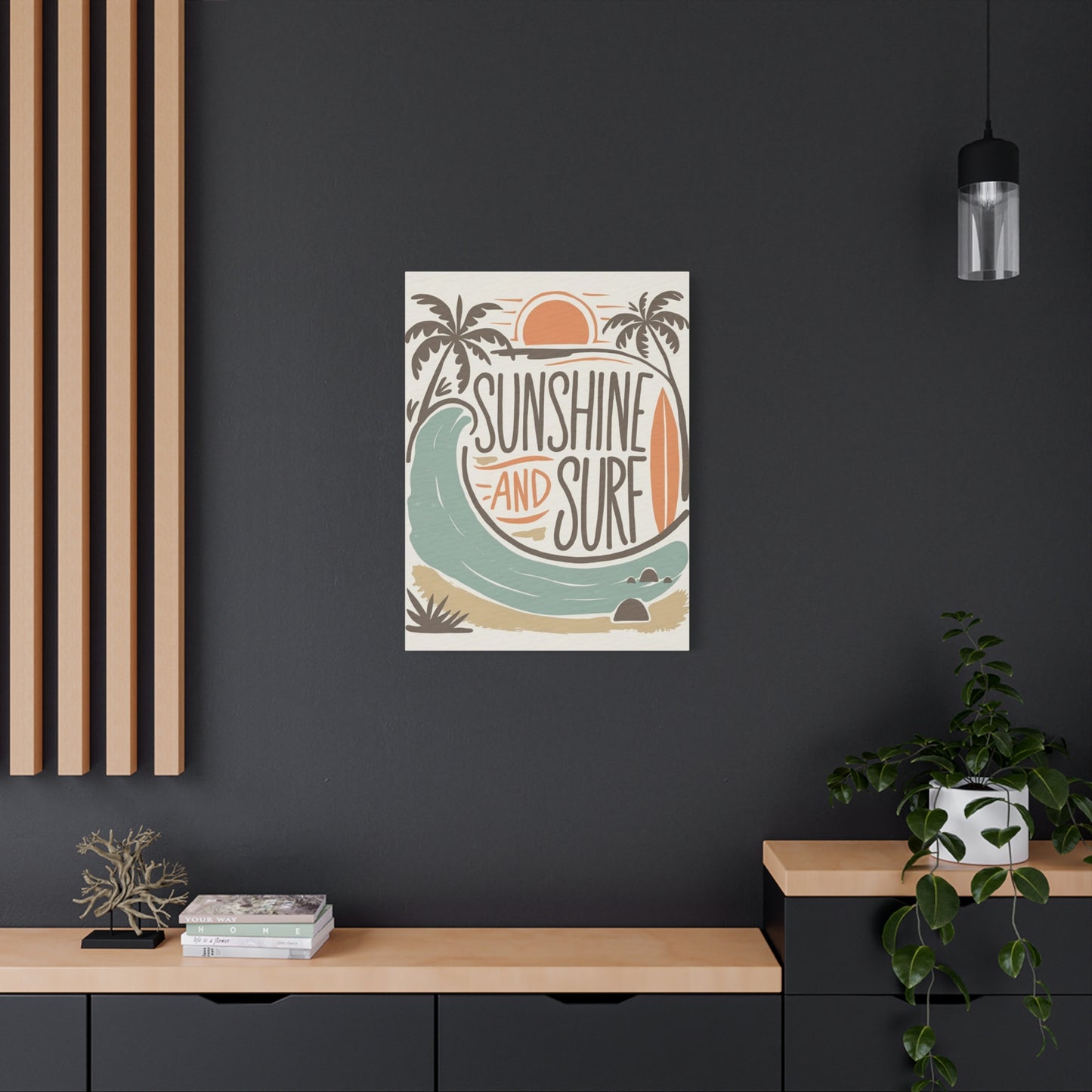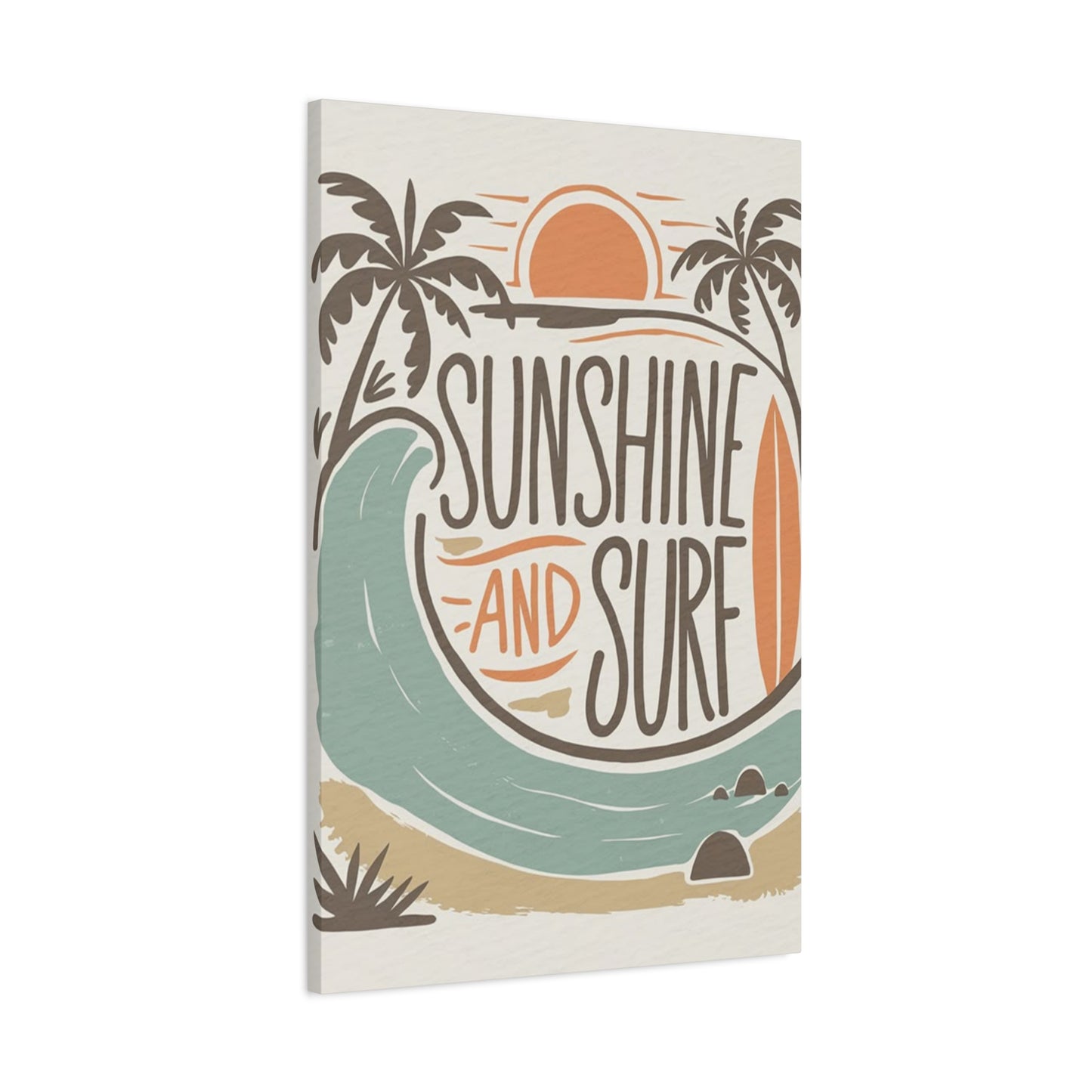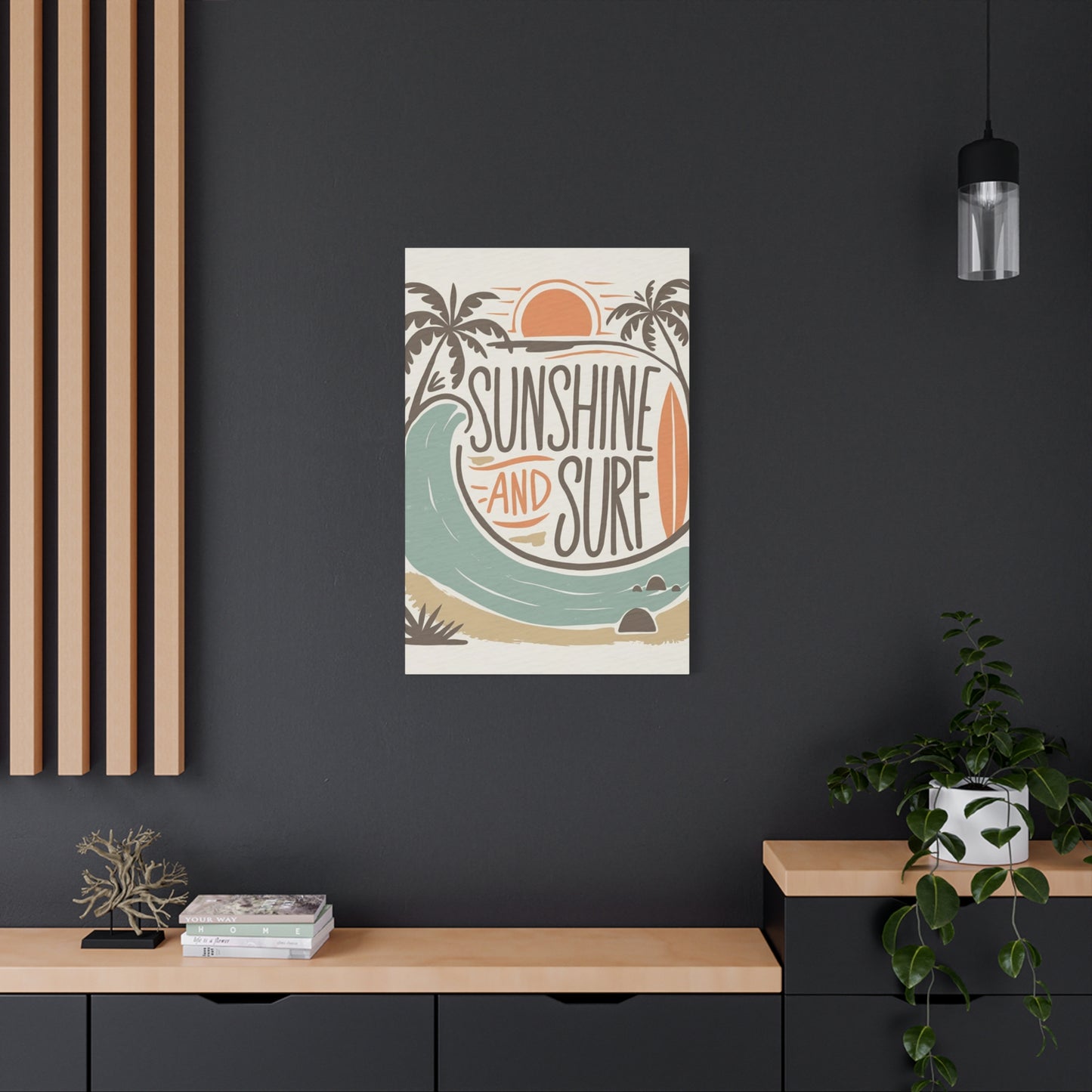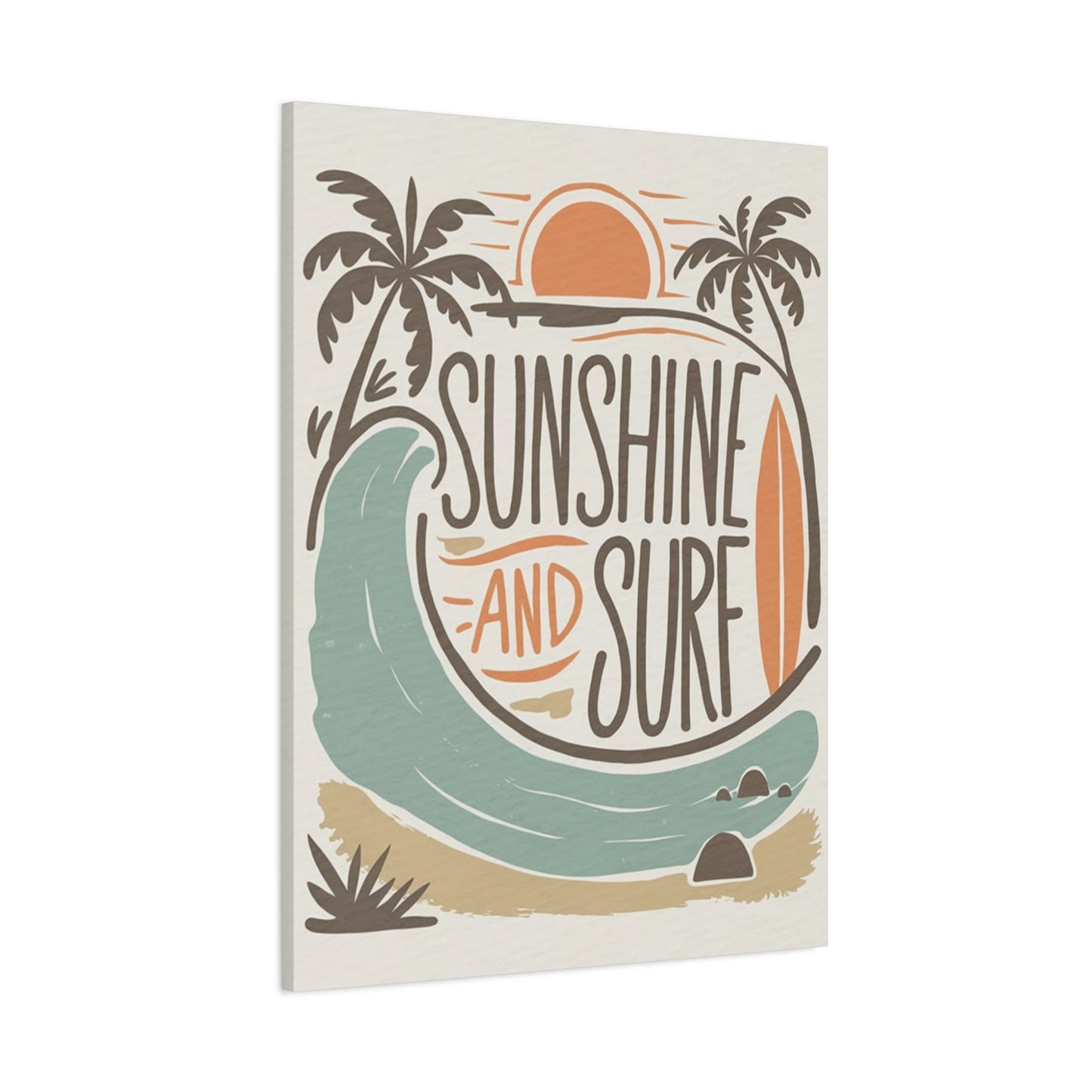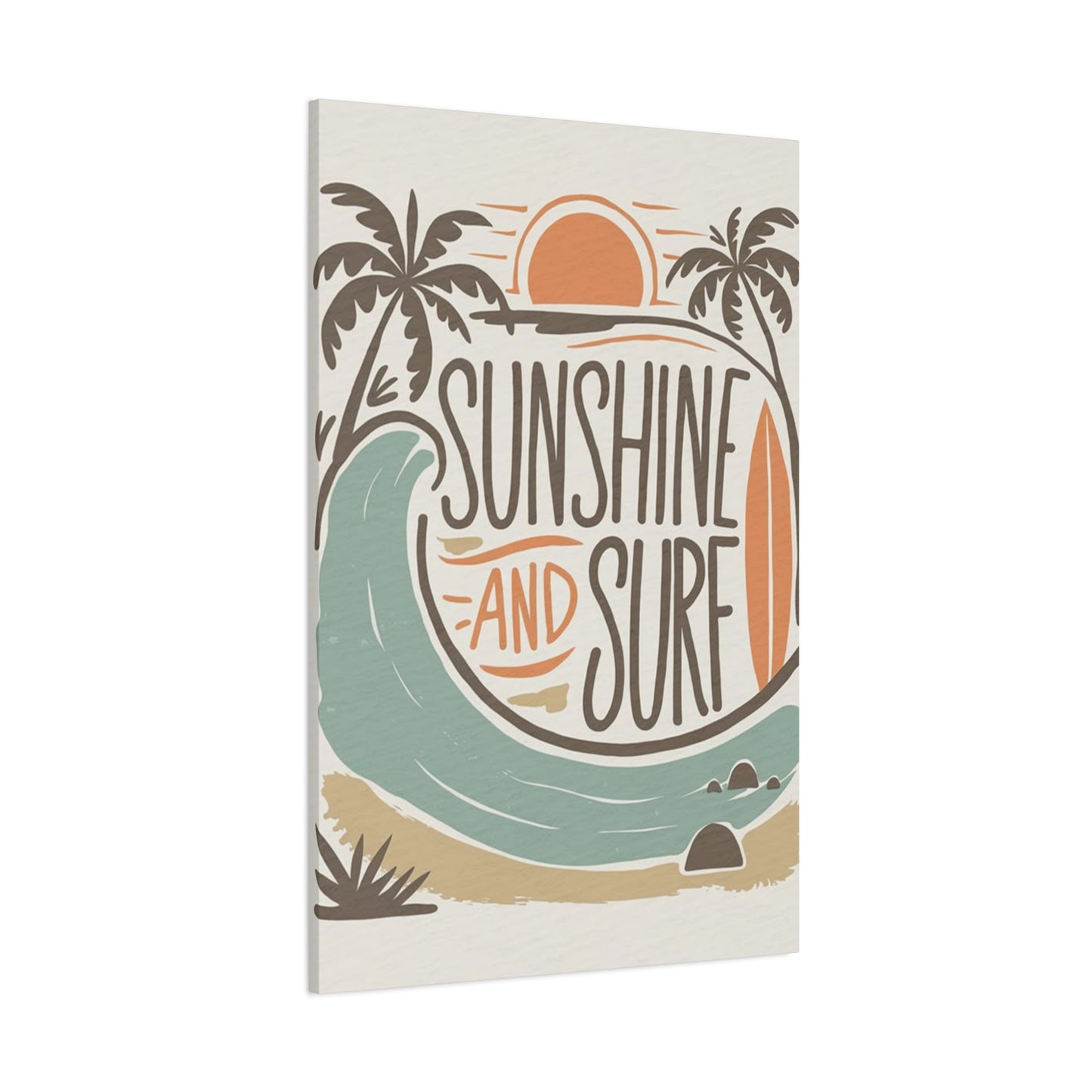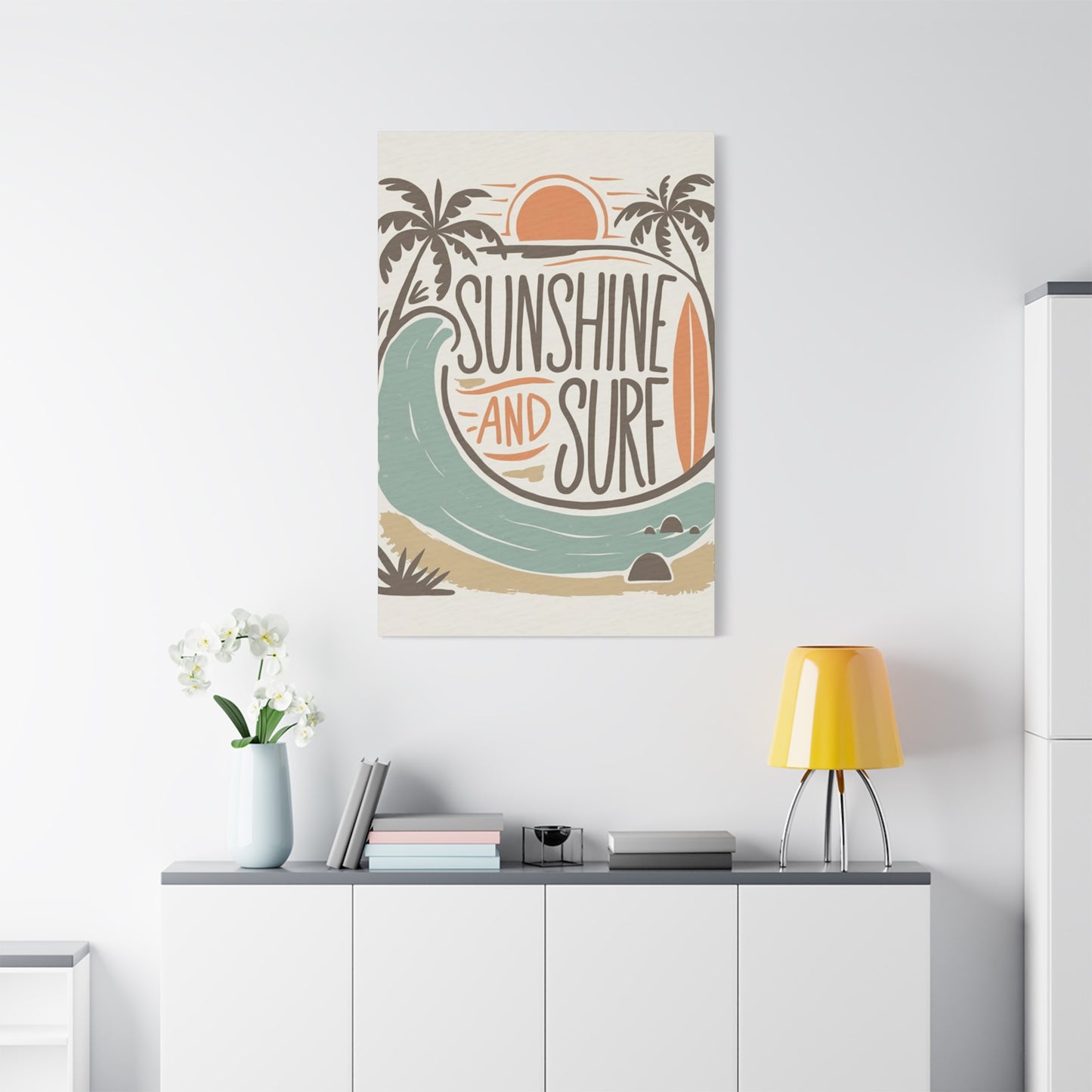Surf and Sunshine Wall Art: Ocean-Inspired Canvas Prints for Every Home
The allure of coastal living extends far beyond geographical boundaries, reaching into homes across the globe through carefully selected ocean-themed artwork. Surf and sunshine wall art represents more than mere decoration; it embodies a lifestyle philosophy that celebrates freedom, natural beauty, and the timeless appeal of oceanic environments. These artistic pieces serve as windows to paradise, transforming ordinary rooms into sanctuaries that evoke the serenity and excitement of coastal life.
Canvas prints featuring surf and sunshine themes have revolutionized how homeowners approach coastal-inspired decor. Unlike traditional paintings, these modern alternatives offer affordability without compromising artistic quality. The printing technology used in contemporary canvas production ensures vibrant colors that capture the essence of golden sunsets, turquoise waves, and pristine beaches. Each piece becomes a conversation starter, inviting viewers to imagine themselves walking along sandy shores or riding perfect waves.
The psychological impact of ocean-themed artwork cannot be understated. Research consistently demonstrates that exposure to natural imagery, particularly scenes involving water and sunlight, can significantly reduce stress levels and promote mental well-being. Surf and sunshine wall art brings these therapeutic benefits directly into living environments, creating daily opportunities for mental escape and relaxation. The rhythmic patterns of waves depicted in surf art mirror natural breathing patterns, while sunny imagery triggers the release of mood-enhancing neurotransmitters.
Selecting appropriate surf and sunshine canvas prints requires understanding how these pieces interact with existing architectural elements and color schemes. The organic curves of wave formations complement both modern minimalist designs and traditional furnishings, making ocean-themed artwork incredibly versatile. Sunshine elements add warmth to cooler color palettes while surf imagery introduces movement and energy to static room arrangements.
Professional curators recommend considering the scale relationship between artwork and wall dimensions when selecting surf and sunshine pieces. Oversized canvas prints work exceptionally well in spacious areas with high ceilings, while smaller collections suit intimate settings like bedrooms or reading nooks. The key lies in achieving visual balance that enhances rather than overwhelms the existing environment.
Capturing Coastal Essence Through Artistic Ocean Canvas
Ocean canvas art represents a sophisticated fusion of natural beauty and artistic interpretation. Contemporary artists specializing in coastal themes employ various techniques to capture the dynamic nature of marine environments. From photorealistic depictions of crashing waves to abstract interpretations of ocean movement, these artworks offer diverse approaches to bringing coastal energy indoors.
The technical aspects of creating exceptional ocean canvas prints involve understanding light behavior on water surfaces. Artists must master the representation of reflection, refraction, and transparency to achieve authenticity in their surf-themed works. The interplay between sunlight and ocean water creates countless variations in color temperature and intensity, challenging artists to capture these fleeting moments on canvas.
Modern printing technologies have revolutionized the reproduction of ocean-themed artwork. High-resolution digital printing allows for precise color matching and detail preservation, ensuring that canvas reproductions maintain the vibrancy and depth of original paintings. UV-resistant inks prevent fading, allowing surf and sunshine wall art to maintain its visual impact for decades.
The cultural significance of ocean imagery extends across numerous civilizations and time periods. From ancient maritime traditions to contemporary surf culture, oceanic themes have consistently represented adventure, freedom, and connection with natural forces. This universal appeal makes surf and sunshine wall art suitable for diverse cultural contexts and personal preferences.
Understanding color theory enhances the selection process for ocean-themed canvas prints. Cool blues and greens naturally recede, creating depth and tranquility, while warm yellows and oranges advance, adding energy and focal interest. Successful surf and sunshine compositions often incorporate both temperature ranges, establishing visual tension that keeps viewers engaged while maintaining overall harmony.
Texture plays a crucial role in effective ocean canvas art. Artists employ various brushwork techniques to simulate different water conditions, from smooth tropical lagoons to turbulent storm seas. Canvas prints can successfully reproduce these textural elements through advanced printing processes that apply varying ink densities to create tactile illusions.
Bringing Paradise Indoors with Tropical Beach Canvas Prints
Tropical beach canvas prints offer an immediate transportation system to paradise, regardless of geographical location or climate conditions. These artistic pieces capture the essence of exotic destinations, featuring pristine coastlines, swaying palm trees, and crystal-clear waters that embody the ultimate vacation mindset. The popularity of tropical beach artwork stems from its ability to evoke powerful emotional responses associated with relaxation, escape, and natural beauty.
The compositional elements common in tropical beach canvas prints follow established artistic principles while celebrating unique coastal characteristics. Horizontal lines created by shorelines establish stability and calm, while diagonal palm fronds introduce dynamic movement. The interplay between these linear elements creates visual rhythm that mirrors the natural patterns found in tropical environments.
Color palettes in tropical beach artwork typically emphasize warm, saturated hues that reflect the intense sunlight characteristic of equatorial regions. Turquoise waters contrast beautifully with golden sands, while emerald palm fronds provide organic shapes that break up expansive sky areas. These color relationships work harmoniously in various room settings, from contemporary apartments to traditional beach houses.
Lighting considerations become particularly important when displaying tropical beach canvas prints. Natural light enhances the luminous qualities inherent in these artworks, but direct sunlight can cause premature fading. Strategic placement near windows with filtered light or supplemental artificial lighting can maximize visual impact while protecting the investment.
The psychological benefits of tropical imagery extend beyond simple aesthetic pleasure. Studies indicate that viewing tropical scenes can lower blood pressure, reduce anxiety, and improve overall mood. These physiological responses make tropical beach canvas prints particularly valuable for high-stress environments like offices or medical facilities.
Size selection for tropical beach artwork depends on the intended emotional impact and available wall dimensions. Large-format prints create immersive experiences that can make viewers feel transported to the depicted location. Smaller pieces work effectively as accent elements within broader decorative schemes, providing subtle reminders of tropical paradise without dominating the visual field.
Framing options for tropical beach canvas prints should complement rather than compete with the artwork itself. Natural materials like bamboo or weathered wood enhance the organic qualities of tropical imagery, while sleek metal frames suit more contemporary interpretations. Gallery-wrapped canvas eliminates framing requirements while creating clean, modern presentations.
Surfboard Art Pieces for Authentic Ocean Atmosphere
Surfboard art represents a unique intersection between functional objects and artistic expression, bringing authentic surf culture directly into residential and commercial environments. These distinctive pieces range from vintage longboards adorned with traditional Pacific Islander motifs to contemporary shortboards featuring abstract wave patterns. The three-dimensional nature of surfboard art creates visual interest that flat canvas prints cannot achieve, establishing focal points that command attention while celebrating surf heritage.
The history of surfboard decoration traces back centuries to Polynesian cultures, where boards served both practical and ceremonial purposes. Traditional designs incorporated spiritual symbols and natural elements, reflecting the deep connection between surfers and oceanic forces. Contemporary surfboard artists honor these traditions while incorporating modern aesthetic sensibilities and materials, creating pieces that resonate with both surf enthusiasts and art collectors.
Authentic surfboard art pieces often feature weathered finishes that simulate years of ocean exposure, adding character and storytelling elements to the artwork. Artists achieve these effects through various aging techniques, including sanding, staining, and controlled weathering processes. The resulting patina suggests adventures in remote breaks and countless dawn patrol sessions, appealing to viewers' sense of wanderlust and adventure.
The scale of surfboard art makes these pieces particularly suitable for large wall areas that might overwhelm smaller canvas prints. A well-positioned surfboard can anchor an entire room's decorative scheme while providing conversation opportunities about surf culture, travel experiences, and oceanic adventures. The vertical orientation of most surfboards works especially well in areas with high ceilings or narrow wall configurations.
Installation considerations for surfboard art differ significantly from traditional hanging artwork. These pieces require sturdy mounting systems capable of supporting considerable weight while maintaining proper wall clearance. Professional installation ensures safety while preserving both the artwork and wall integrity. Some surfboard art pieces incorporate lighting elements that illuminate decorative features while creating dramatic shadows.
Maintenance requirements for surfboard art vary depending on materials and finishes. Sealed pieces resist moisture and dust accumulation, making them suitable for humid environments like bathrooms or poolside areas. Unfinished or deliberately weathered pieces may require occasional treatment to prevent deterioration while maintaining their authentic appearance.
The investment value of quality surfboard art continues to appreciate as surf culture gains mainstream acceptance and vintage boards become increasingly rare. Limited edition pieces by recognized artists often command premium prices, making surfboard art both decorative and potentially profitable investments for collectors who appreciate surf culture authenticity.
Seascape Photography Prints for Realistic Ocean Views
Seascape photography prints offer unparalleled realism in capturing the raw beauty and power of oceanic environments. Unlike painted interpretations, photographic prints document actual moments in time, preserving specific lighting conditions, weather patterns, and wave formations that might never occur again. These authentic representations appeal to viewers who prefer documentary accuracy over artistic interpretation while still providing the emotional benefits associated with ocean imagery.
The technical challenges involved in seascape photography require specialized equipment and expertise to overcome. Saltwater spray, changing light conditions, and unpredictable wave patterns demand photographers who understand both marine environments and advanced camera techniques. Long exposure methods create ethereal effects that smooth wave motion into silky abstractions, while high-speed capture freezes dramatic splash formations in crystal-clear detail.
Professional seascape photographers often spend years developing relationships with specific coastal locations, learning optimal shooting conditions and seasonal variations. This intimate knowledge allows them to capture extraordinary moments that casual observers might miss entirely. The resulting prints represent not just photographic skill but deep understanding of oceanic behavior and natural light patterns.
Color accuracy becomes paramount in seascape photography prints, as viewers intuitively recognize authentic ocean hues from personal experience. Advanced printing technologies and color-managed workflows ensure that reproductions maintain the subtle gradations and intense saturation characteristic of marine environments. Metallic printing substrates can enhance the luminous qualities of water and sky, creating prints that seem to glow from within.
The emotional impact of realistic seascape prints often exceeds that of stylized artwork because viewers can easily imagine themselves within the depicted scenes. A photograph of a perfect wave breaking over a coral reef allows viewers to mentally experience the sound, smell, and movement of that specific moment. This visceral connection makes seascape photography particularly effective for creating immersive coastal environments.
Printing size significantly affects the impact of seascape photography. Large-format prints can create panoramic views that fill peripheral vision, enhancing the illusion of actually being at the coast. Smaller prints work effectively in intimate settings where subtle beauty appreciation takes precedence over dramatic impact. Multiple smaller prints can create narrative sequences showing wave progression or tidal changes.
Limited edition seascape prints often include detailed information about capture conditions, camera settings, and location specifics. This documentation adds educational value while increasing collectibility for photography enthusiasts. Signed and numbered prints by established seascape photographers represent significant investment opportunities within the fine art photography market.
Wave Pattern Canvas Designs for Dynamic Visual Impact
Wave pattern canvas designs harness the inherent dynamism of oceanic movement to create artworks that energize and transform living environments. These pieces focus specifically on the repetitive yet ever-changing patterns created by wave formations, abstracting natural rhythms into visual compositions that work effectively across diverse decorative styles. The mathematical precision underlying wave patterns appeals to viewers who appreciate both natural beauty and geometric harmony.
The scientific study of wave mechanics provides artists with foundational understanding necessary for creating convincing wave pattern designs. Oceanographers recognize distinct wave types, each producing characteristic visual signatures that experienced artists can interpret and stylize. From gentle swells to violent storm waves, each formation offers unique compositional opportunities that skilled artists exploit for maximum visual impact.
Color selection in wave pattern artwork significantly influences emotional response and compatibility with existing room elements. Monochromatic wave patterns create sophisticated, gallery-worthy presentations that emphasize form over specific oceanic references. Realistic color schemes maintain clear connections to natural wave formations, while fantasy palettes allow artists to explore impossible combinations that prioritize aesthetic impact over documentary accuracy.
Abstract wave pattern designs often incorporate mathematical principles like the golden ratio and Fibonacci sequences, reflecting the natural order underlying oceanic systems. These mathematical relationships create inherently pleasing compositions that satisfy viewers on subconscious levels. Artists who understand these principles can create wave patterns that feel naturally harmonious even when employing non-naturalistic color schemes.
The directional flow inherent in wave patterns must be carefully considered during installation to maximize desired effects. Horizontally oriented wave patterns emphasize room width and create calming sensations, while vertical orientations add height perception and energy. Diagonal wave flows can guide viewer attention toward specific room features or architectural elements, making wave pattern art valuable tools for visual room organization.
Layered wave pattern designs create depth illusions that make walls appear to recede, effectively expanding perceived room dimensions. Artists achieve these effects through careful color temperature manipulation, perspective techniques, and overlapping pattern elements. The resulting compositions can transform small rooms into seemingly expansive coastal environments.
Contemporary wave pattern artists increasingly incorporate mixed media elements that add textural variety and dimensional interest. Raised gel applications simulate wave foam, while embedded sand or shell fragments provide tactile authenticity. These enhanced pieces bridge the gap between traditional canvas prints and sculptural artwork, offering unique aesthetic experiences that purely printed pieces cannot achieve.
Blue Ocean Hues for Calming Coastal Environments
Blue ocean hues possess unique psychological properties that make them exceptionally valuable for creating calming coastal environments within residential and commercial settings. The physiological response to blue wavelengths includes reduced heart rate, lowered blood pressure, and decreased stress hormone production, making ocean-blue artwork particularly beneficial for relaxation-focused areas like bedrooms, meditation rooms, and spa facilities.
The range of blue tones found in oceanic environments spans from pale aquamarine to deep navy, each carrying distinct emotional associations and practical applications. Lighter blues suggest tropical shallows and peaceful lagoons, promoting feelings of serenity and escape. Darker blues evoke deeper waters and mystery, adding sophistication and contemplative qualities to room environments. Successful ocean-themed artwork often incorporates multiple blue variations to create depth and visual interest.
Color temperature relationships between different blue hues significantly affect overall room atmosphere. Cool blues naturally recede, making rooms appear larger and more spacious, while warmer blue-greens advance slightly, creating more intimate environments. Understanding these effects allows homeowners to select ocean art that enhances rather than conflicts with existing architectural proportions and lighting conditions.
The cultural associations with blue ocean colors extend across numerous societies and historical periods, consistently representing peace, stability, and spiritual connection. These universal positive associations make blue-dominant ocean art suitable for diverse cultural contexts and personal preferences. The timeless appeal of ocean blues ensures that investments in blue-themed artwork remain relevant regardless of changing decorative trends.
Natural light interactions with blue ocean artwork create dynamic displays that change throughout the day. Morning light emphasizes cooler blue tones, while afternoon illumination brings out warmer undertones and green influences. Evening artificial lighting can dramatically transform blue-dominant artwork, sometimes revealing hidden color depths or creating entirely new visual experiences.
Complementary color relationships enhance the impact of blue ocean artwork when incorporated thoughtfully into broader decorative schemes. Orange and coral accents create vibrant contrasts that energize blue-dominant compositions, while yellow elements add warmth and luminosity. Green additions enhance the natural qualities of ocean blues, creating harmonious combinations that feel organically cohesive.
The practical advantages of blue-dominant ocean artwork extend beyond aesthetic considerations to include versatility in room coordination. Blue hues coordinate effectively with neutral color schemes, allowing flexibility in furniture selection and seasonal decorative changes. This adaptability makes blue ocean art particularly valuable for homeowners who prefer evolving decorative approaches rather than permanent color commitments.
Sandy Beach Artwork for Warm Coastal Ambiance
Sandy beach artwork introduces warm, earthy elements that balance the cool tones typically associated with oceanic themes, creating comprehensive coastal environments that feel both refreshing and welcoming. These pieces celebrate the tactile qualities of sandy shores, often incorporating textural elements that invite viewer interaction and provide sensory richness beyond purely visual appeal. The neutral color palette characteristic of sandy beaches makes these artworks exceptionally versatile for coordination with diverse decorative schemes.
The artistic representation of sand textures challenges artists to capture the subtle variations in grain size, moisture content, and mineral composition that create authentic beach appearances. Successful sandy beach artwork often employs layered techniques that build complexity gradually, starting with base tones and adding highlights, shadows, and textural details that simulate the random patterns created by wind and wave action.
Color variations in sandy beach artwork reflect the diverse geological compositions found along different coastlines. Caribbean beaches feature brilliant white sands derived from crushed coral, while volcanic regions produce dramatic black sand formations. Mediterranean shores often display golden tones that warm entire room environments, while Pacific Northwest beaches feature gray-brown compositions that coordinate beautifully with contemporary neutral palettes.
The compositional role of sandy areas in coastal artwork provides visual grounding that stabilizes more dynamic elements like waves and clouds. Horizontal shorelines create peaceful foundations that allow other elements to shine without overwhelming viewers. Diagonal beach perspectives add movement and depth, guiding viewer attention through the composition while maintaining overall harmony.
Lighting considerations become particularly important when displaying sandy beach artwork, as sand surfaces reflect and scatter light in complex ways that affect color perception. Direct lighting can create harsh contrasts that flatten sandy textures, while indirect illumination enhances the subtle variations that make sand appear three-dimensional and inviting. Understanding these relationships helps homeowners achieve optimal presentation results.
The psychological associations with sandy beaches include childhood memories, vacation experiences, and leisure activities that promote positive emotional responses. These associations make sandy beach artwork particularly effective for family areas, guest rooms, and recreational areas where relaxation and positive mood enhancement are primary objectives. The familiar comfort of sandy beach imagery appeals to viewers across age groups and cultural backgrounds.
Contemporary sandy beach artists increasingly incorporate mixed media elements that add authentic textural qualities to their works. Real sand applications, embedded shell fragments, and raised texture mediums create pieces that engage multiple senses simultaneously. These enhanced artworks bridge the gap between traditional prints and sculptural installations, offering unique aesthetic experiences that purely visual pieces cannot provide.
Sunset Over Ocean Canvas for Evening Warmth
Sunset over ocean canvas art captures one of nature's most spectacular daily performances, bringing the dramatic beauty of golden hour illumination into indoor environments. These pieces celebrate the magical transformation that occurs when daylight gradually surrenders to darkness, creating atmospheric conditions that photographers and painters have struggled to capture effectively for centuries. The warm color palettes characteristic of sunset imagery provide natural antidotes to cool artificial lighting, making these artworks particularly valuable for evening relaxation areas.
The technical challenges involved in representing sunset lighting require sophisticated understanding of atmospheric optics and color temperature relationships. Artists must master the subtle gradations between intense orange horizon lines and deeper purple sky regions, while accurately depicting the complex reflections and refractions that occur when low-angle sunlight interacts with water surfaces. Successful sunset ocean artwork often employs glazing techniques that build luminous depth gradually through multiple transparent color layers.
The emotional impact of sunset imagery stems from profound human connections to daily light cycles and natural rhythm awareness. Evolutionary psychology suggests that sunset viewing triggers deep relaxation responses that prepare organisms for sleep and recovery. These biological programming elements make sunset ocean artwork particularly effective for bedrooms, meditation areas, and other environments where stress reduction and mental preparation for rest are important objectives.
Color temperature progression in sunset ocean artwork creates natural viewing sequences that guide attention across the composition. Viewers typically begin with the brightest horizon elements before exploring the surrounding sky and water areas, following the same visual pattern used when viewing actual sunsets. This predictable viewing behavior allows artists to strategically place compositional elements for maximum impact and narrative development.
The symbolic significance of sunsets extends across numerous cultures and spiritual traditions, consistently representing completion, reflection, and transition between active and restful periods. These universal associations make sunset ocean artwork appropriate for diverse personal beliefs and cultural backgrounds, while providing opportunities for contemplation and peaceful reflection that enhance daily life quality.
Seasonal variations in sunset characteristics allow artists to create series of related pieces that reflect changing atmospheric conditions throughout the year. Summer sunsets often feature clear skies and intense colors, while winter presentations may include dramatic cloud formations and more subdued palettes. These variations provide opportunities for seasonal artwork rotation that keeps room environments fresh and dynamic.
The investment potential of quality sunset ocean artwork continues to appreciate as collectors recognize the technical skill required for effective light representation and the timeless appeal of these natural phenomena. Limited edition prints by established artists often command premium prices, making sunset ocean art both decorative and potentially profitable investments for discriminating collectors who appreciate natural beauty and artistic excellence.
Modern Surf Art Styles for Contemporary Homes
Modern surf art styles represent a sophisticated evolution from traditional beach-themed decoration, incorporating contemporary aesthetic sensibilities while maintaining authentic connections to surf culture and oceanic environments. These innovative approaches appeal to homeowners who appreciate surf culture but prefer subtle, refined presentations over obvious coastal clichés. Contemporary surf artists employ minimalist techniques, abstract interpretations, and unexpected material combinations to create pieces that work effectively within modern architectural contexts.
The minimalist approach to surf art emphasizes essential elements while eliminating superfluous details that might appear dated or overly literal. Clean lines replace complex wave formations, while restricted color palettes focus attention on form and composition rather than realistic representation. These simplified presentations coordinate beautifully with contemporary furniture and architectural elements, making modern surf art suitable for sophisticated urban environments where traditional beach themes might feel inappropriate.
Abstract surf art interpretations allow artists to capture the energy and movement of oceanic environments without literal representation. Gestural brushwork suggests wave motion, while color field techniques evoke the emotional responses associated with surf experiences. These non-representational approaches appeal to viewers who prefer conceptual rather than documentary artwork, while still providing the psychological benefits associated with oceanic imagery.
Material innovation in modern surf art includes unexpected substrate choices and mixed media applications that challenge traditional canvas print limitations. Metal printing creates luminous effects that enhance water imagery, while acrylic mounting systems add dimensional depth that simulates looking through ocean water. These technical innovations distinguish contemporary surf art from mass-produced alternatives while demonstrating artistic innovation and commitment to excellence.
The integration of digital techniques in modern surf art production allows artists to achieve effects impossible through traditional methods alone. Computer-generated wave patterns can be combined with photographic elements to create hybrid compositions that maintain authenticity while exploring impossible perspectives and lighting conditions. These digital enhancements expand creative possibilities without abandoning the natural beauty that makes surf art appealing.
Scale considerations in modern surf art often favor oversized presentations that create immersive viewing experiences. Large format pieces transform walls into viewing portals, making viewers feel transported to oceanic environments despite being indoors. This dramatic approach works particularly well in contemporary homes with expansive wall areas and high ceilings that can accommodate substantial artwork installations.
The collectibility of modern surf art continues to grow as established galleries recognize the artistic merit and cultural significance of contemporary surf-inspired artwork. Museum acquisitions and critical recognition validate surf art as legitimate fine art rather than mere decoration, increasing investment potential for collectors who recognize quality and innovation in contemporary surf art productions.
Tropical Fish and Coral Canvas Prints for Underwater Beauty
Tropical fish and coral canvas prints bring the spectacular diversity of underwater ecosystems directly into terrestrial environments, celebrating the incredible variety of marine life that thrives in warm ocean waters. These vibrant artworks showcase nature's most creative color combinations and organic forms, providing educational opportunities alongside aesthetic enjoyment. The complexity and beauty of coral reef systems offer endless inspiration for artists who specialize in marine biology themes.
The scientific accuracy required for effective tropical fish and coral artwork demands extensive research and often direct observation through diving or snorkeling expeditions. Artists must understand anatomical details, behavioral patterns, and ecological relationships to create convincing underwater scenes that satisfy both aesthetic and educational criteria. This commitment to accuracy distinguishes quality marine life artwork from generic interpretations that lack biological authenticity.
Color relationships in tropical marine environments often defy conventional artistic guidelines, featuring combinations that would seem garish in terrestrial contexts but appear perfectly natural underwater. Brilliant yellows compete with electric blues, while neon greens contrast with intense purples in combinations that create visual excitement without appearing artificial. These natural color palettes provide inspiration for room decorating schemes that celebrate vibrancy and life energy.
The three-dimensional quality of coral formations presents unique compositional challenges that artists must solve to create effective two-dimensional representations. Successful coral artwork often employs layering techniques that build depth gradually, starting with background elements and adding foreground details that create convincing spatial relationships. These depth illusions can make rooms appear larger while providing fascinating viewing opportunities that reveal new details upon closer examination.
Educational value adds significant worth to quality tropical fish and coral artwork, particularly in family environments where learning opportunities are valued. Children naturally gravitate toward colorful marine life imagery, while detailed representations can spark interest in marine biology, environmental conservation, and ocean exploration. This educational component makes tropical marine artwork particularly suitable for schools, libraries, and family areas.
The conservation message inherent in tropical marine artwork becomes increasingly important as coral reef systems face environmental threats. Beautiful representations of healthy reef ecosystems can inspire viewers to support conservation efforts while providing baseline imagery of what healthy coral communities should resemble. This environmental awareness aspect adds meaningful depth to purely decorative considerations.
Contemporary printing technologies excel at reproducing the luminous qualities characteristic of tropical marine life. Metallic inks and specialty substrates can simulate the iridescent properties of fish scales and the translucent qualities of coral polyps. These technical capabilities ensure that printed reproductions maintain the visual impact and biological authenticity that make tropical marine artwork so compelling.
Sailing and Yacht Art for Nautical Elegance
Sailing and yacht art embodies the sophisticated aspects of maritime culture, celebrating human relationships with oceanic environments through elegant vessels and refined seamanship traditions. These artworks appeal to viewers who appreciate both natural beauty and human achievement, recognizing sailing as one of humanity's oldest and most graceful methods of ocean travel. The combination of natural forces and human skill creates dynamic compositions that suggest adventure, freedom, and mastery over challenging environments.
The technical accuracy required for convincing sailing artwork demands understanding of vessel design, rigging systems, and sailing physics. Artists must comprehend how wind interactions with various sail configurations create forward motion, while accurately depicting the complex relationships between hull design and water displacement. This technical knowledge distinguishes quality sailing art from generic boat imagery that lacks nautical authenticity.
Historical sailing vessels provide rich subjects for artists who appreciate traditional craftsmanship and maritime heritage. Classic yacht designs, tall ships, and racing sailboats each offer unique aesthetic qualities and cultural associations that appeal to different viewer preferences. Vintage sailing art often incorporates period details and weathered finishes that suggest decades of ocean adventures and maritime experiences.
Color palettes in sailing artwork typically emphasize the contrast between pristine white sails and deep blue waters, creating classic combinations that never appear dated. These timeless color relationships coordinate effectively with both traditional and contemporary room designs, making sailing art exceptionally versatile for various decorative applications. Accent colors in flags, hull details, and sunset skies add visual interest without overwhelming the fundamental elegance of sailing imagery.
The symbolic associations with sailing extend beyond mere transportation to encompass themes of exploration, self-reliance, and harmony with natural forces. These deeper meanings make sailing art particularly appropriate for personal studies, offices, and other environments where inspiration and motivation are valued. The aspirational qualities of sailing imagery encourage viewers to pursue their own adventures and personal growth objectives.
Movement and dynamism in sailing artwork create energy that enlivens static room environments. Billowing sails, spray patterns, and tilted yacht angles suggest speed and excitement, while maintaining the refined elegance associated with sailing culture. This combination of energy and sophistication makes sailing art suitable for both active areas like family rooms and formal settings like dining rooms or professional offices.
The investment value of quality sailing art continues to appreciate as maritime culture gains recognition for its historical significance and contemporary relevance. Limited edition prints by recognized marine artists often increase in value over time, making sailing artwork both decorative and potentially profitable investments for collectors who appreciate nautical themes and artistic excellence.
Vintage Coastal Travel Posters for Nostalgic Appeal
Vintage coastal travel posters represent a golden age of tourism promotion when graphic design simplicity and artistic elegance combined to create compelling destination imagery. These historical artifacts celebrate specific coastal locations while embodying the optimistic spirit of mid-twentieth century travel culture. The nostalgic appeal of vintage travel posters extends beyond mere decoration to encompass cultural history, graphic design appreciation, and romantic idealization of simpler times.
The design principles employed in vintage coastal travel posters reflect sophisticated understanding of visual communication and mass appeal techniques. Bold typography, simplified color palettes, and iconic imagery work together to create instantly recognizable destination identities that remain effective decades after their original creation. These design lessons continue to influence contemporary graphic design while providing timeless aesthetic experiences for modern viewers.
Reproduction quality becomes particularly important when displaying vintage coastal travel posters, as modern printing capabilities can either enhance or diminish their original artistic impact. High-quality reproductions maintain the subtle color gradations and crisp typography that made original posters effective, while poor reproductions flatten the sophisticated color relationships and lose the elegant simplicity that makes vintage posters appealing.
The cultural significance of specific coastal destinations featured in vintage travel posters adds educational value alongside aesthetic appeal. Posters promoting destinations like French Riviera resorts, California beach communities, and Mediterranean coastal towns provide historical glimpses into tourism development and changing travel patterns. This historical context makes vintage coastal travel posters particularly suitable for educational environments and culturally aware households.
Color relationships in vintage coastal travel posters often employ limited palettes that maximize impact while maintaining production economy constraints of their era. These restricted color schemes create harmonious presentations that coordinate easily with contemporary room designs, while the historical color choices add authentic period character that distinguishes vintage posters from modern reproductions or contemporary coastal artwork.
The nostalgic emotional responses triggered by vintage coastal travel posters stem from collective cultural memories of idealized vacation experiences and simpler lifestyle aspirations. These emotional connections make vintage travel posters particularly effective for creating welcoming environments in guest areas, vacation homes, and hospitality settings where positive associations and relaxed atmospheres are desired objectives.
Contemporary appreciation for vintage coastal travel posters continues to grow as collectors recognize their artistic merit, historical significance, and design influence on modern graphic arts. Original posters in good condition command substantial prices, while quality reproductions provide affordable access to these design classics for homeowners who appreciate vintage aesthetics and travel culture history.
Abstract Ocean Wave Paintings for Artistic Interpretation
Abstract ocean wave paintings liberate artists from literal representation requirements, allowing creative interpretation of oceanic energy and movement through non-representational techniques. These artistic approaches capture the essential qualities of wave motion, water dynamics, and oceanic power without relying on realistic depiction, appealing to viewers who prefer conceptual rather than documentary artwork. Abstract wave paintings often achieve greater emotional impact than realistic representations by focusing on feeling and energy rather than visual accuracy.
The technical challenges involved in abstract wave painting require sophisticated understanding of color theory, compositional dynamics, and material properties. Artists must convey the essence of wave motion through brushwork, color transitions, and textural variations that suggest rather than depict oceanic characteristics. These abstract techniques often prove more technically demanding than realistic representation, requiring years of study and experimentation to achieve mastery.
Color relationships in abstract wave paintings can explore impossible combinations that prioritize emotional impact over realistic accuracy. Fantasy palettes incorporating unexpected hues can create striking visual experiences while maintaining essential wave-like qualities through form and movement. These creative color choices allow abstract wave paintings to coordinate with diverse room designs while maintaining their oceanic associations.
Gestural techniques in abstract wave painting capture the spontaneous energy associated with ocean movement, employing brushwork that mirrors the fluid motions of water itself. These gestural approaches often produce more convincing representations of wave energy than careful realistic rendering, as the physical act of painting becomes analogous to the natural processes being depicted. Viewers respond viscerally to gestural wave paintings because they suggest rather than literally describe oceanic experiences.
Scale considerations become particularly important in abstract wave paintings, as larger formats allow for more expansive gestural techniques and immersive viewing experiences. Room-sized abstract wave paintings can transform entire environments into oceanic experiences, while smaller pieces work effectively as focal points within broader decorative schemes. The abstract nature of these works makes them particularly suitable for contemporary architectural contexts.
The investment potential of quality abstract wave paintings depends largely on artist recognition and technique innovation. Established artists who have developed distinctive approaches to wave abstraction often see their works appreciate significantly over time, as collectors recognize both artistic merit and rarity. Abstract wave paintings by emerging artists represent more affordable entry points into serious art collecting while offering significant appreciation potential.
Contemporary critics increasingly recognize abstract ocean artwork as legitimate fine art rather than decorative painting, validating the artistic merit and cultural significance of ocean-inspired abstraction. Museum acquisitions and gallery representation enhance the credibility and investment value of abstract wave paintings while expanding their cultural influence beyond purely decorative applications.
Minimalist Beach Scenes for Clean Modern Aesthetics
Minimalist beach scenes strip away unnecessary details to focus on essential elements that capture coastal beauty through simplified compositions and restricted color palettes. These refined approaches appeal to contemporary aesthetic sensibilities while maintaining clear connections to oceanic environments, making minimalist beach art particularly suitable for modern architectural contexts where simplicity and elegance are valued over complexity and ornamentation.
The design principles underlying effective minimalist beach art require careful editing and sophisticated compositional understanding. Artists must identify the most essential elements that define beach environments, eliminating superfluous details while maintaining recognizable coastal characteristics. This reduction process often proves more challenging than complex realistic representation, as every remaining element must justify its inclusion through functional or aesthetic necessity.
Color selection in minimalist beach artwork typically employs restricted palettes that maximize impact through subtle variations rather than dramatic contrasts. Monochromatic approaches can create sophisticated presentations that emphasize form and texture over specific color relationships, while limited color schemes focus attention on compositional elements rather than chromatic variety. These restrained color choices coordinate beautifully with contemporary neutral palettes common in modern room designs.
Negative space utilization becomes particularly important in minimalist beach compositions, as empty areas provide visual relief while allowing remaining elements to achieve greater prominence. Skilled minimalist artists understand that negative space functions as an active compositional element rather than mere background, using empty areas to create balance, suggest scale, and guide viewer attention through the artwork.
The psychological impact of minimalist beach art often exceeds that of complex alternatives because simplified compositions allow viewers to project their own coastal memories and associations onto the artwork. This participatory aspect makes minimalist beach scenes more personally meaningful while reducing the risk of viewer fatigue that complex compositions sometimes create. The meditative qualities of simplified coastal imagery promote relaxation and mental clarity.
Material choices in minimalist beach art can enhance the clean aesthetic through careful substrate and presentation selections. Smooth canvas surfaces, gallery wrapping, and elimination of decorative frames create presentations that emphasize the artwork itself rather than surrounding elements. These clean presentation methods align with minimalist philosophy while ensuring that artwork integrates seamlessly with contemporary architectural environments.
Contemporary collectors increasingly appreciate minimalist beach art for its timeless aesthetic qualities and coordination flexibility. These pieces remain relevant despite changing decorative trends while providing sophisticated coastal references that work effectively in diverse room contexts. The investment stability of quality minimalist beach art makes it particularly attractive for collectors who value both aesthetic appeal and financial prudence.
Lighthouse and Coastal Structure Art for Maritime Heritage
Lighthouse and coastal structure art celebrates the functional beauty of maritime architecture while honoring the critical role these structures play in ocean navigation and coastal safety. These artworks combine aesthetic appreciation with historical recognition, appealing to viewers who value both visual beauty and cultural heritage. Lighthouse imagery carries powerful symbolic associations with guidance, safety, and human perseverance against natural challenges.
The architectural diversity of lighthouse designs provides artists with rich subject matter that spans numerous historical periods and regional styles. From simple colonial towers to elaborate Victorian structures, each lighthouse design reflects specific technological capabilities, aesthetic preferences, and environmental challenges of its construction era. This architectural variety ensures that lighthouse art can coordinate with diverse decorative styles while maintaining authentic historical character.
Regional lighthouse characteristics often incorporate local materials and construction techniques that reflect specific coastal environments and cultural traditions. New England lighthouses feature granite construction and austere designs that withstand harsh winter storms, while Mediterranean examples often employ colorful stucco finishes that complement warmer climates. These regional variations provide educational opportunities alongside aesthetic enjoyment.
The symbolic significance of lighthouses extends far beyond their practical navigation functions to encompass themes of hope, guidance, and sanctuary that resonate across diverse cultural contexts. These universal associations make lighthouse art particularly appropriate for personal studies, meditation areas, and other environments where inspiration and contemplation are valued. The aspirational qualities of lighthouse imagery encourage viewers to pursue their own guiding principles and personal growth objectives.
Technical accuracy in lighthouse artwork requires understanding of both architectural details and maritime operational requirements. Artists must comprehend how lens systems, rotation mechanisms, and signal patterns function to create convincing representations that satisfy knowledgeable viewers while maintaining artistic merit. This technical authenticity distinguishes quality lighthouse art from generic representations that lack maritime credibility.
Conclusion
Surf and sunshine wall art effortlessly captures the invigorating spirit of coastal living, bringing the vibrant energy of the ocean and warmth of the sun right into your home. These ocean-inspired canvas prints evoke feelings of freedom, adventure, and relaxation, transforming any room into a bright, uplifting sanctuary reminiscent of sun-soaked beaches and rolling waves. Whether you favor dynamic surf scenes, serene sunrises, or abstract interpretations of sea and light, this art style celebrates the timeless allure of the shore.
One of the key reasons surf and sunshine wall art resonates so deeply is its ability to transport you mentally to the coast, offering a refreshing escape from everyday stress. The vivid blues of the ocean combined with the golden hues of sunlight create a visually stunning and mood-boosting palette. This fusion of colors energizes your living spaces and brings a sense of balance and harmony, making it perfect for living rooms, bedrooms, or even home offices seeking a breath of fresh air.
Incorporating surf and sunshine art also aligns beautifully with a variety of interior styles. It enhances coastal, nautical, and beach-themed décor with authentic imagery, while its lively colors and natural motifs can add zest to modern, bohemian, or eclectic spaces. The versatility of canvas prints allows you to choose sizes and compositions that either command attention as focal points or subtly complement your existing décor.
Beyond its aesthetic appeal, surf and sunshine wall art embodies the joy of outdoor living and the timeless connection between nature and well-being. The imagery of waves and sunlight reminds us of the simple pleasures of life—freedom, movement, and warmth—and encourages a mindset of positivity and relaxation.
In conclusion, surf and sunshine wall art is a vibrant and refreshing way to infuse your home with the spirit of the sea and sun. Its dynamic energy, warm colors, and natural beauty transform interiors into inviting coastal retreats. Whether you’re a beach lover or simply drawn to the uplifting vibes of ocean life, these canvas prints offer endless inspiration for making your home a brighter, happier place.



















